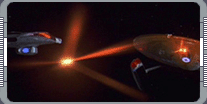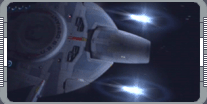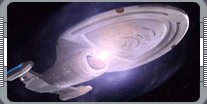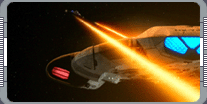Phasers are a Federation vessel's primary defense weapon, gathered in a series of high-powered arrays at
key locations on the hull. Starship phasers have range of 300,000 kilometers and capable of a 5.1
megawatt burst. By the late 24th century phasers were only effective at sublight speeds for close-range
attacks. Control of the integrated phaser system is coordinated from the tactical/security station on the
main bridge. The phaser's power output, dispersion beam width, and length of burst can be adjusted. On
occasions where the automatic controls are disrupted or damaged, it is possible to target and fire the
phasers manually, although this is less precise. Some shield configurations can deflect a phaser beam; an
interferometric pulse, for example, can reflect the directed energy away from the target, rendering phasers
ineffective. Under normal conditions, however, phasers are a formidable and adaptable defense; for example,
the harmonics of the beam can be adjusted to cut through solid rock when needed for rescue missions.
 Pulse Phaser Cannons
Pulse Phaser Cannons
Starship phaser arrays had changed relatively little in more than a century, until recently. Pulse phaser
cannons, developed at a Starfleet R&D facility in Tokyo, Japan, using large, nearly flawless emitter
crystals artficially grown in microgravity chambers. Phaser arrays use a disposable cylindrical power cell
about a meter in length. They were designed as part of the Borg defensive and first installed on the
prototype starship
USS Defiant NX-74205. The new crystals, combined with
rapid-discharge EPS capacitance banks and high-speed beam-focusing coils, allowed the phaser discharge to be
stored temporarily (up to 2.3 nanoseconds) within the coils and then released as a layered pulse. Pulse phaser
cannons have begun to be installed on newer starships as primary weapons along with phaser arrays.
 Photon Torpedoes
Photon Torpedoes
Photon torpedoes are powerful weapons containing matter and antimatter separated by a forcefield which collapses
on impact. Torpedoes, unlike phasers can be fired while at warp speeds and use a warp sustainer engine to
maintain speed. Starships usually carry type-6 photon torpedoes; their explosive potential can be modified by
varying the amount of antimatter to increase or decrease the yield, measured in isotons. Typically set at a
yield of 18.5 isotons, the weapons' destructive potential can be maximized by firing them in a pre-set spread
pattern, providing a cumulative detonation toward a target. In case of damage to the launchers, they can be
manually launched from the torpedo bay, although personnel are at risk from potential burns. The torpedoes are
highly adaptable; their warheads can be modified for firing on specific targets with a range of up to 3,500,000
kilometers.
Read more about Photon Torpedoes
 Quantum Torpedoes
Quantum Torpedoes
The quantum torpedo is the first Starfleet follow-on weapon to replace the standard photon torpedo first
developed in 2268. Existing and future threat force conflicts drove the development of a new defensive standoff
weapon that could be deployed on specially equipped starships, starbases, and planetary-surface fortifications.
The quantum torpedo consists of a pressure-molded shell of densified tritanium and duranium foam, trapezoidal
in cross section and tapered at the forward end for atmospheric applications. A 7-millimeter layer of
plasma-bonded terminium ceramic forms an ablative armor skin for the foam hull, over which is bonded a
.12-millimeter coating of silicon-copper-yttrium rigid polymer as an antiradiation coating. The chamber measures
.76 meters in diameter by 1.38 meters in length and 2.3 centimeters in average thickness. The zero-point
initiator is powered by the detonation of an uprated photon torpedo warhead with a yield of 21.8 isotons
 Deflector Shields
Deflector Shields
Shields are an energy field that encompass the entire vessel during hazardous situations. The shields are
generated through the grid that covers the upper port and starboard sides of a ship's engineering hull, and
it consists of a projected energy barrier whose frequency can be modulated or rotated to maximize its
effectiveness against attack. Starfleet shield design is extremely flexible, and can be modified by alien
technologies to temporarily strengthen or change the nature of shield harmonics, as well as be extended to
protect another starship within the shield bubble. In their normal operating state, shields are highly
susceptible to any chroniton-based weapons. They cannot halt the advance of a chroniton torpedo, because it
is in a state of temporal flux, although if the exact temporal variance of a weapon is known, the shields
can be adapted to produce highly effective temporal shielding.
 Ablative Hull Armor
Ablative Hull Armor
Ablative armor is a protective skin that is a top secret technology that was in development during the Borg
defensive weapons project along with pulse phaser cannons and quantum torpedoes. Ablative armor provided
an extra layer of defense for the vessel against enemy fire if the shields failed. It worked by forming a
protective layer over the hull surface that helped disperse large amounts of incoming phaser blasts.
Ablative armor was so classified that Starfleet Operations was unaware that the Defiant had been equipped
with it until 2372. By 2374 other prototype starships such as the
USS Prometheus NX-74913 had ablative armor installed.